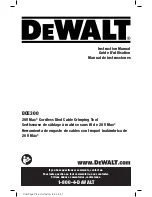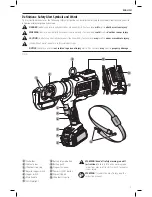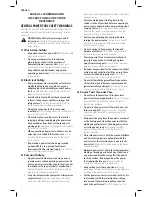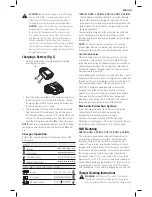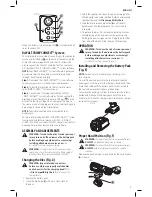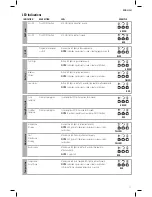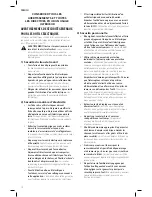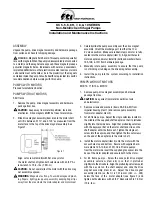
English
8
a cloth or soft non-metallic brush. Do not use water or
any cleaning solutions.
Important Charging Notes
1. Longest life and best performance can be obtained if
the battery pack is charged when the air temperature is
between 65 °F and 75 °F (18 ° – 24 °C). DO NOT charge
the battery pack in an air temperature below +40 °F
(+4.5 °C), or above +104 °F (+40 °C). This is important
and will prevent serious damage to the battery pack.
2. The charger and battery pack may become warm to the
touch while charging. This is a normal condition, and
does not indicate a problem. To facilitate the cooling of
the battery pack after use, avoid placing the charger or
battery pack in a warm environment such as in a metal
shed or an uninsulated trailer.
3. If the battery pack does not charge properly:
a. Check operation of receptacle by plugging in a lamp
or other appliance;
b. Check to see if receptacle is connected to a light
switch which turns power off when you turn out the
lights;
c. Move the charger and battery pack to a location
where the surrounding air temperature is
approximately 65 °F – 75 °F (18 ° – 24 °C);
d. If charging problems persist, take the tool, battery
pack and charger to your local service center.
4. The battery pack should be recharged when it fails to
produce sufficient power on jobs which were easily
done previously. DO NOT CONTINUE to use under these
conditions. Follow the charging procedure. You may
also charge a partially used pack whenever you desire
with no adverse effect on the battery pack.
5. Foreign materials of a conductive nature such as, but
not limited to, grinding dust, metal chips, steel wool,
aluminum foil, or any buildup of metallic particles
should be kept away from charger cavities. Always
unplug the charger from the power supply when there
is no battery pack in the cavity. Unplug the charger
before attempting to clean.
6. Do not freeze or immerse the charger in water or any
other liquid.
Storage Recommendations
1. The best storage place is one that is cool and dry, away
from direct sunlight and excess heat or cold.
2. For long storage, it is recommended to store a fully
charged battery pack in a cool dry place out of the
charger for optimal results.
nOTE:
Battery packs should not be stored completely
depleted of charge. The battery pack will need to be
recharged before use.
SAVE THESE INSTRUCTIONS FOR
FUTURE USE
COMPONENTS (FIG. A)
WARNING:
Never modify the power tool or any part
of it. Damage or personal injury could result.
Refer to Figure A at the beginning of this manual for a
complete list of components.
INTENDED USE
This Cordless Died Cable Crimping Tool is designed for
professional crimping of specific electrical applications only.
Only trained personnel should operate this tool.
DO nOT
use under wet conditions or in presence of
flammable liquids or gases.
This crimping tool is a professional power tool.
DO nOT
let children come into contact with the tool. Supervision is
required when inexperienced operators use this tool.
Introduction
The DCE300 Cordless Died Cable Crimping Tool uses an
electric motor to power a hydraulic piston pump. The
pumping action forces a ram forward that forces closed
a set of dies (not included). When used with appropriate
crimping dies, the DCE300 is designed to mechanically
crimp connectors onto cable to create a tight and
permanent connection.
Trigger Switch (Fig. A)
Squeezing the trigger switch
5
advances the hydraulic
ram
2
, while fully releasing the trigger switch stops the
advance of the hydraulic ram.
Reverse Trigger Switch (Fig. A)
Squeezing the reverse trigger switch
4
retracts the
hydraulic ram which releases the crimping action.
Shoulder Strap (Fig. A)
WARNING:
The shoulder strap and ring are intended
for transporting the tool. They are not intended for
tethering or securing the tool to a person or object
during use.
WARNING:
Do not transport the tool with the main
power ON. Switch the main power OFF prior to
transporting.
Your crimping tool comes with a shoulder strap. Hook the
shoulder strap clips
13
into the shoulder strap ring
3
.
LED Worklight (Fig. A)
The LED worklight
7
is located on the foot of the tool. The
worklight is activated when the trigger switch is depressed.
It will remain on for 2 minutes. After 1 minute, 40 seconds,
the light will dim to 25% indicating that the light is going
to turn off.
LED Display (Fig. D)
The LED display on the top of the crimping tool includes
the power ON/OFF button
11
maintenance LED
14
, cycle
complete LED
15
, battery state of charge LED
16
, and
temperature LEDs
17
. Refer to the
LED Indications
chart
for specific information.

